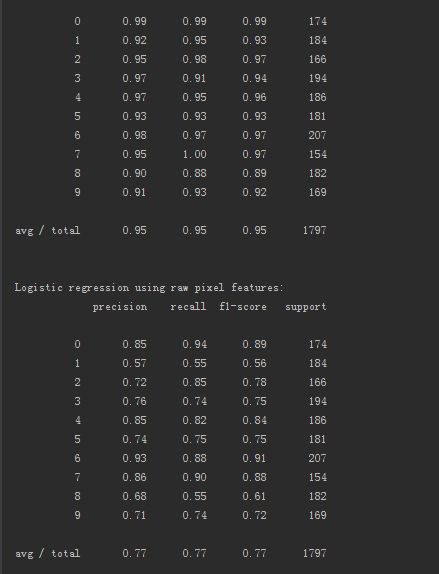使用Python scikit-learn 库实现神经网络算法
1:神经网络算法简介
2:Backpropagation算法详细介绍
3:非线性转化方程举例
4:自己实现神经网络算法NeuralNetwork
5:基于NeuralNetwork的XOR实例
6:基于NeuralNetwork的手写数字识别实例
7:scikit-learn中BernoulliRBM使用实例
8:scikit-learn中的手写数字识别实例
一:神经网络算法简介
1:背景
以人脑神经网络为启发,历史上出现过很多版本,但最著名的是backpropagation
2:多层向前神经网络(Multilayer Feed-Forward Neural Network)
多层向前神经网络组成部分
输入层(input layer),隐藏层(hiddenlayer),输出层(output layer)
3:设计神经网络结构
4:算法验证——交叉验证法(Cross- Validation)
解读: 有一组输入集A,B,可以分成三组,第一次以第一组为训练集,求出一个准确度,第二次以第二组作为训练集,求出一个准确度,求出准确度,第三次以第三组作为训练集,求出一个准确度,然后对三个准确度求平均值
二:Backpropagation算法详细介绍
1:通过迭代性来处理训练集中的实例
2:输入层输入数
经过权重计算得到第一层的数据,第一层的数据作为第二层的输入,再次经过权重计算得到结果,结果和真实值之间是存在误差的,然后根据误差,反向的更新每两个连接之间的权重
3:算法详细介绍
输入:D : 数据集,| 学习率(learning rate),一个多层前向神经网络



 Tj:真实值,Qj表示预测值
Tj:真实值,Qj表示预测值 Errk 表示前一层的误差, Wjk表示前一层与当前点的连接权重
Errk 表示前一层的误差, Wjk表示前一层与当前点的连接权重 l:指学习比率(变化率),手工指定,优化方法是,随着数据的迭代逐渐减小
l:指学习比率(变化率),手工指定,优化方法是,随着数据的迭代逐渐减小 l:同上
l:同上4:结合实例讲解算法
0.9对用的是L,学习率
测试代码如下:
1.NeutralNetwork.py文件代码
#coding:utf-8 import numpy as np #定义双曲函数和他们的导数
def tanh(x):
return np.tanh(x) def tanh_deriv(x):
return 1.0 - np.tanh(x)**2 def logistic(x):
return 1/(1 + np.exp(-x)) def logistic_derivative(x):
return logistic(x)*(1-logistic(x)) #定义NeuralNetwork 神经网络算法
class NeuralNetwork:
#初始化,layes表示的是一个list,eg[10,10,3]表示第一层10个神经元,第二层10个神经元,第三层3个神经元
def __init__(self, layers, activation='tanh'):
"""
:param layers: A list containing the number of units in each layer.
Should be at least two values
:param activation: The activation function to be used. Can be
"logistic" or "tanh"
"""
if activation == 'logistic':
self.activation = logistic
self.activation_deriv = logistic_derivative
elif activation == 'tanh':
self.activation = tanh
self.activation_deriv = tanh_deriv self.weights = []
#循环从1开始,相当于以第二层为基准,进行权重的初始化
for i in range(1, len(layers) - 1):
#对当前神经节点的前驱赋值
self.weights.append((2*np.random.random((layers[i - 1] + 1, layers[i] + 1))-1)*0.25)
#对当前神经节点的后继赋值
self.weights.append((2*np.random.random((layers[i] + 1, layers[i + 1]))-1)*0.25) #训练函数 ,X矩阵,每行是一个实例 ,y是每个实例对应的结果,learning_rate 学习率,
# epochs,表示抽样的方法对神经网络进行更新的最大次数
def fit(self, X, y, learning_rate=0.2, epochs=10000):
X = np.atleast_2d(X) #确定X至少是二维的数据
temp = np.ones([X.shape[0], X.shape[1]+1]) #初始化矩阵
temp[:, 0:-1] = X # adding the bias unit to the input layer
X = temp
y = np.array(y) #把list转换成array的形式 for k in range(epochs):
#随机选取一行,对神经网络进行更新
i = np.random.randint(X.shape[0])
a = [X[i]] #完成所有正向的更新
for l in range(len(self.weights)):
a.append(self.activation(np.dot(a[l], self.weights[l])))
#
error = y[i] - a[-1]
deltas = [error * self.activation_deriv(a[-1])] #开始反向计算误差,更新权重
for l in range(len(a) - 2, 0, -1): # we need to begin at the second to last layer
deltas.append(deltas[-1].dot(self.weights[l].T)*self.activation_deriv(a[l]))
deltas.reverse()
for i in range(len(self.weights)):
layer = np.atleast_2d(a[i])
delta = np.atleast_2d(deltas[i])
self.weights[i] += learning_rate * layer.T.dot(delta) #预测函数
def predict(self, x):
x = np.array(x)
temp = np.ones(x.shape[0]+1)
temp[0:-1] = x
a = temp
for l in range(0, len(self.weights)):
a = self.activation(np.dot(a, self.weights[l]))
return a
2、测试代码
#coding:utf-8
'''
#基于NeuralNetwork的XOR(异或)示例
import numpy as np
from NeuralNetwork import NeuralNetwork nn = NeuralNetwork([2,2,1], 'tanh')
X = np.array([[0, 0], [0, 1], [1, 0], [1, 1]])
y = np.array([0, 1, 1, 0])
nn.fit(X, y)
for i in [[0, 0], [0, 1], [1, 0], [1,1]]:
print(i,nn.predict(i))
'''
'''
#基于NeuralNetwork的手写数字识别示例
import numpy as np
from sklearn.datasets import load_digits
from sklearn.metrics import confusion_matrix,classification_report
from sklearn.preprocessing import LabelBinarizer
from sklearn.cross_validation import train_test_split
from NeuralNetwork import NeuralNetwork digits = load_digits()
X = digits.data
y = digits.target
X -= X.min()
X /= X.max() nn =NeuralNetwork([64,100,10],'logistic')
X_train, X_test, y_train, y_test = train_test_split(X, y)
labels_train = LabelBinarizer().fit_transform(y_train)
labels_test = LabelBinarizer().fit_transform(y_test)
print "start fitting"
nn.fit(X_train,labels_train,epochs=3000)
predictions = []
for i in range(X_test.shape[0]):
o = nn.predict(X_test[i])
predictions.append(np.argmax(o))
print confusion_matrix(y_test, predictions)
print classification_report(y_test, predictions)
''' #scikit-learn中的手写数字识别实例
import numpy as np
import matplotlib.pyplot as plt from scipy.ndimage import convolve
from sklearn import linear_model, datasets, metrics
from sklearn.cross_validation import train_test_split
from sklearn.neural_network import BernoulliRBM
from sklearn.pipeline import Pipeline ###############################################################################
# Setting up def nudge_dataset(X, Y): direction_vectors = [
[[0, 1, 0],
[0, 0, 0],
[0, 0, 0]], [[0, 0, 0],
[1, 0, 0],
[0, 0, 0]], [[0, 0, 0],
[0, 0, 1],
[0, 0, 0]], [[0, 0, 0],
[0, 0, 0],
[0, 1, 0]]] shift = lambda x, w: convolve(x.reshape((8, 8)), mode='constant',
weights=w).ravel()
X = np.concatenate([X] +
[np.apply_along_axis(shift, 1, X, vector)
for vector in direction_vectors])
Y = np.concatenate([Y for _ in range(5)], axis=0)
return X, Y # Load Data
digits = datasets.load_digits()
X = np.asarray(digits.data, 'float32')
X, Y = nudge_dataset(X, digits.target)
X = (X - np.min(X, 0)) / (np.max(X, 0) + 0.0001) # 0-1 scaling X_train, X_test, Y_train, Y_test = train_test_split(X, Y,
test_size=0.2,
random_state=0) # Models we will use
logistic = linear_model.LogisticRegression()
rbm = BernoulliRBM(random_state=0, verbose=True) classifier = Pipeline(steps=[('rbm', rbm), ('logistic', logistic)]) ###############################################################################
# Training # Hyper-parameters. These were set by cross-validation,
# using a GridSearchCV. Here we are not performing cross-validation to
# save time.
rbm.learning_rate = 0.06
rbm.n_iter = 20
# More components tend to give better prediction performance, but larger
# fitting time
rbm.n_components = 100
logistic.C = 6000.0 # Training RBM-Logistic Pipeline
classifier.fit(X_train, Y_train) # Training Logistic regression
logistic_classifier = linear_model.LogisticRegression(C=100.0)
logistic_classifier.fit(X_train, Y_train) ###############################################################################
# Evaluation print()
print("Logistic regression using RBM features:\n%s\n" % (
metrics.classification_report(
Y_test,
classifier.predict(X_test)))) print("Logistic regression using raw pixel features:\n%s\n" % (
metrics.classification_report(
Y_test,
logistic_classifier.predict(X_test)))) ###############################################################################
# Plotting plt.figure(figsize=(4.2, 4))
for i, comp in enumerate(rbm.components_):
plt.subplot(10, 10, i + 1)
plt.imshow(comp.reshape((8, 8)), cmap=plt.cm.gray_r,
interpolation='nearest')
plt.xticks(())
plt.yticks(())
plt.suptitle('100 components extracted by RBM', fontsize=16)
plt.subplots_adjust(0.08, 0.02, 0.92, 0.85, 0.08, 0.23) plt.show() '''
from sklearn.neural_network import BernoulliRBM
X = [[0,0],[1,1]]
y = [0,1]
clf = BernoulliRBM().fit(X,y)
测试结果如下:


使用Python scikit-learn 库实现神经网络算法的更多相关文章
- python复杂网络库networkx:算法
http://blog.csdn.net/pipisorry/article/details/54020333 Networks算法Algorithms 最短路径Shortest Paths shor ...
- day-11 python自带库实现2层简单神经网络算法
深度神经网络算法,是基于神经网络算法的一种拓展,其层数更深,达到多层,本文以简单神经网络为例,利用梯度下降算法进行反向更新来训练神经网络权重和偏向参数,文章最后,基于Python 库实现了一个简单神经 ...
- Scikit Learn: 在python中机器学习
转自:http://my.oschina.net/u/175377/blog/84420#OSC_h2_23 Scikit Learn: 在python中机器学习 Warning 警告:有些没能理解的 ...
- day-9 sklearn库和python自带库实现最近邻KNN算法
K最近邻(k-Nearest Neighbor,KNN)分类算法,是一个理论上比较成熟的方法,也是最简单的机器学习算法之一.该方法的思路是:如果一个样本在特征空间中的k个最相似(即特征空间中最邻近)的 ...
- Python实现神经网络算法识别手写数字集
最近忙里偷闲学习了一点机器学习的知识,看到神经网络算法时我和阿Kun便想到要将它用Python代码实现.我们用了两种不同的方法来编写它.这里只放出我的代码. MNIST数据集基于美国国家标准与技术研究 ...
- scikit learn 模块 调参 pipeline+girdsearch 数据举例:文档分类 (python代码)
scikit learn 模块 调参 pipeline+girdsearch 数据举例:文档分类数据集 fetch_20newsgroups #-*- coding: UTF-8 -*- import ...
- 吴裕雄 python 人工智能——基于神经网络算法在智能医疗诊断中的应用探索代码简要展示
#K-NN分类 import os import sys import time import operator import cx_Oracle import numpy as np import ...
- python 各种开源库
测试开发 来源:https://www.jianshu.com/p/ea6f7fb69501 Web UI测试自动化 splinter - web UI测试工具,基于selnium封装. 链接 sel ...
- Python常用的库简单介绍一下
Python常用的库简单介绍一下fuzzywuzzy ,字符串模糊匹配. esmre ,正则表达式的加速器. colorama 主要用来给文本添加各种颜色,并且非常简单易用. Prettytable ...
随机推荐
- .NET截取指定长度字符超出部分以"..."代替
/// <summary> /// 将指定字符串按指定长度进行剪切, /// </summary> /// <param name= "Str "&g ...
- vue报错 vue-cli 引入 stylus 失败
1.1.1. vue-cli 引入 stylus 失败 先通过vue-cli的webpack模板建立文件夹: vue init webpack test-stylus 然后安装依赖 npm ins ...
- [ jQuery ] scrollTop与offset()!
jQuery scrollTop() 与offset()! 曾经很长一段时间,很多人问我下面一段代码的好处是什么? ;(function($){ //do something })(jQuery); ...
- qt——类大全
qt类总结地址 http://www.kuqin.com/qtdocument/ QWidget.QDialog及QMainWindow的区别 QWidget类是所有用户界面对象的基类. 窗口部件是用 ...
- 第1章 1.6计算机网络概述--OSI参考模型
ISO七层模式:国际标准组织对互联网通信规则进行的定义. 7.应用层:所有能产生网络流量的程序,如:QQ. 6.表示层:传输前对数据进行进行处理,是一种数据处理的规则,如:加密.压缩.传输二进制(图片 ...
- 【PGM】Representation--Knowledge Engineering,不同的模型表示,变量的类型,structure & parameters
Part 1. 重要的区别: Template based vs. specific Directed vs. undirected Generative vs. discrimina ...
- 关于Serializable的一个形象的例子
一.知识预备 根据使用Serializable的使用场景,可以发现所涉及的场景都是跨进程的,就是要做的事情不是在一个java进程中完成的,我们都知道java进程是基于jvm跑起来的,而每一个被创建出来 ...
- uva11732 Trie转化
有40001 个单词每个单词长度不超过1000,每个两个单词之间都要比较求要比较次数 int strcmp(char *s,char *t){ int i; for(i = 0; s[i]==t[i] ...
- C# 解析soap数据为json格式
数据格式: <soap:Envelope xmlns:soap="http://schemas.xmlsoap.org/soap/envelope/"> <soa ...
- flask nginx+uwsgi超时设置
最近使用uwsgi+nginx经常程序执行一般就跳转到nginx报错页面,查看停止时程序日志还在写,nginx报错upstream timeout排查怀疑是超时的问题 设置nginx uwsgi_co ...






